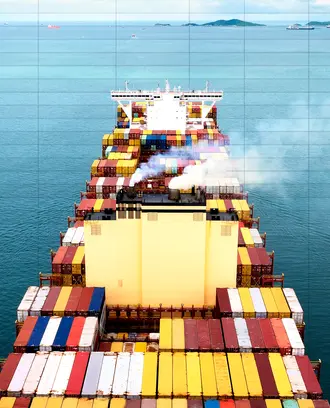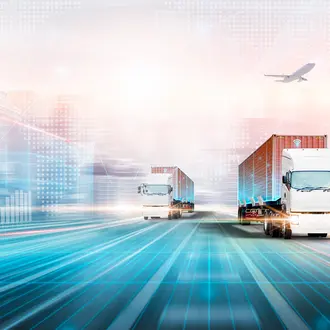Credit: Andrew Soundarajan / iStock
Before the COVID-19 pandemic, many consumers rarely thought about supply chains, which seemed to seamlessly deliver goods to stores and doorsteps. But pandemic-era disruptions lifted the curtain on this seeming magic, according to MIT engineering professor Yossi Sheffi, revealing “the underlying structure, unavoidable complexity, and massive scale of modern supply chains.”
In his new book, “The Magic Conveyor Belt: Supply Chains, AI, and the Future of Work,” Sheffi, the director of the MIT Center for Transportation and Logistics, takes a closer look at supply chains, how they operate, and how new technology might change them. As Sheffi writes in the following excerpt, even the most basic of products — bananas — go through quite a journey to appear, as if from “supply chain Santa Claus and his elves,” on grocery store shelves.
++++++
Every operation along any supply chain requires three types of things to come together in the same place at the same time: input materials, equipment, and labor. This is true even for the somewhat simple supply chain of bananas.
Bananas are the most frequently purchased grocery item in the U.S. They are also popular in the rest of the world: In 2019, banana growers exported more than 21 million tons of bananas worldwide. Tracing the supply chain of bananas seems to be relatively straightforward because the product has only a single “part,” does not require assembly, and comes with its own “packaging.”
As it turns out, bananas at the supermarket are not quite the natural, simple product they seem to be, but rather a manufactured one due to the various production processes, applied chemicals, and transportation involved. A look at the banana supply chain from a Chiquita plantation in Costa Rica to a Shaw’s supermarket shelf in Boston, Massachusetts, illustrates this well.
Nature supplies the three main ingredients to the [bill of materials] of a banana: carbon dioxide, water, and sunlight. However, growing bananas successfully requires other inputs, such as fertilizers and organic matter and nutrients, along with pest-control products.
When a banana cluster reaches the right stage of development — still green, but approaching ripeness — farm laborers cut it down and move it along a metal track to a sorting station. Bunches are then manually inspected for appearance and sorted by size. Packers load the sorted and quality-controlled bananas into 40-pound boxes and stack 48 boxes on a pallet.
At the end of the production line, workers load the one-ton pallets of bananas onto trucks to haul them east to the Costa Rican port of Puerto Moín, in Limón, on the Caribbean Sea. At the port, the pallets are loaded into 40-foot refrigerated containers, each holding 20 pallets. Massive cranes then load hundreds of containers onto vessels bound for New Orleans.
At the port in New Orleans, the banana containers are unloaded from the ship and transported by rail and truck to refrigerated distribution centers owned by Chiquita or a retailer. At the distribution center, workers stack pallets of fruit in sealed ripening rooms. Shortly before shipping the bananas to retail stores, Chiquita injects the rooms with ethylene gas to restart the ripening process. They control the gas exposure to achieve one of the three ripeness levels requested by each retail store: hard green, green, or yellow.
When the bananas reach the retailer’s desired color, they are delivered to retail stores. For example, each day at the Shaw’s Supermarket distribution center in Methuen, Massachusetts, which serves the Greater Boston area, thousands of boxes of bananas are loaded onto trucks with an assortment of other perishable items destined for Shaw’s retail grocery outlets. Fresh produce managers must time the sequence of events just right so the correct number of bananas, at the proper ripening stage, will hit the stores every day.
Note that while the description above focuses on the bananas themselves, each process along the way requires more than the bananas. It requires workers, infrastructure, tools, other inputs, and organizations to manage the operations — be it growing, harvesting, loading, transporting, unloading, cooling, ripening, storing, delivery, and more. And all this just for a simple product requiring no assembly.
Whether at the plantation, where laborers use fertilizers and farm machinery, or in the refrigerated warehouses, where workers use ethylene gas to control how quickly the bananas ripen, every operation requires the combination of labor, material inputs, and equipment.
Supply chains: The magic conveyor belt
For most of my career, when neighbors asked my wife what I was researching and teaching at MIT, her answer, “supply chain management,” drew uncomprehending, blank stares. That all changed following the onset of the COVID-19 pandemic. When my wife asked a Whole Foods supermarket produce clerk, in May 2020, why there were no oranges on the shelf, the 17-year-old casually muttered, “You know, we have supply chain problems, ma’am.”
Before the pandemic, supply chains seldom appeared in the public’s news feed, because even when supply chains were disrupted and some products were not available, the interruptions to people’s lives were not significant. Most supply chain problems were isolated events associated with a local natural disaster, and supply chain managers were able to insulate consumers from most such problems. Store shelves might empty out before a hurricane or winter storm, but that was expected and, in many cases, planned for, thus they did not create large-scale problems.
Anyone can do almost anything if given unlimited time and money. The true magic of modern supply chains is in how much they can do with limited time and restricted budgets. Through decades of developments in theory, practices, and tools for supply chain design, management, and operations, managers learned how to consistently provide a lot of products for little money under most circumstances. Large and small retail outlets offered tens of thousands, if not hundreds of thousands, of different products, ready to put in a cart, buy, and take home. E-commerce outlets offered millions of different products, many with same-day delivery to consumers’ front doors. For the most part, the millions of people who work at retailers, manufacturers, raw materials producers, parts suppliers, warehouses, and freight carriers had created an illusion of a magic cornucopia providing a constant stream of products whenever consumers wanted them.
Related Articles
To a large extent, the high performance of modern supply chains meant that consumers knew they could visit a store (or website), find what they needed, and buy it. And if consumers revisited the retailer later, they would again find the shelves still mostly full of goods, seemingly replenished in the dead of night by a supply chain Santa Claus and his elves. Behind the scenes, a vast network of companies worked hard to create a smooth flow of goods at competitive prices.
Supply chains had run so smoothly and invisibly that The New York Times admitted, “We didn’t even have a logistics beat before the pandemic.” With the start of the COVID-19 pandemic, however, supply chains became victims of their own success. The causes of both the periods of smooth supply chain operations and pandemic-related shortages arise from the underlying structure, unavoidable complexity, and massive scale of modern supply chains.
Adapted from “The Magic Conveyor Belt: Supply Chains, AI, and the Future of Work,” by Yossi Sheffi. © 2023 MIT CTL Media.
Read next: Post-pandemic, supply chains retool for the new (ab)normal



